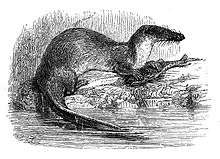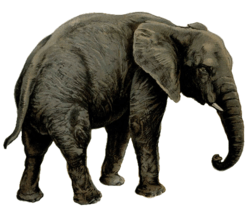Potamogalidae
Potamogalidae is the family of "otter shrews", a group of semiaquatic riverine afrotherian mammals indigenous to sub-Saharan Africa.[1] They are most closely related to the tenrecs of Madagascar, from which they are thought to have split about 47–53 million years ago.[1][2][3] They were formerly considered a subfamily of Tenrecidae.[1]
| Potamogalidae | |
|---|---|
 | |
| Giant otter shrew (Potamogale velox) | |
| Scientific classification | |
| Kingdom: | Animalia |
| Phylum: | Chordata |
| Class: | Mammalia |
| Order: | Afrosoricida |
| Suborder: | Tenrecomorpha |
| Family: | Potamogalidae Allmann, 1865 |
| Genera | |
All otter shrews are carnivorous, preying on any aquatic animal they can find with their sensitive whiskers. As their common name suggests, they bear a strong, but superficial resemblance to true otters to which they are not closely related, nor are they closely related to true shrews. They move through the water by undulating their tail in a side-to-side motion similar to the motions made by a crocodile swimming.
Extant species
Only three species of otter shrew are recognized. Of these, P. velox has a very broad geographic range, M. lamottei has a very restricted range, and M. ruwenzorii is intermediate.
Family Potamogalidae
- Genus Micropotamogale (dwarf otter shrews)
- Nimba otter shrew (M. lamottei)
- Ruwenzori otter shrew (M. ruwenzorii)
- Genus Potamogale
- Giant otter shrew (P. velox)
Phylogeny
Relations between the various afrotherian orders are still being studied. On the basis of molecular studies, elephants and sirenians appear to be sister groups.[4] Potamogalids are sisters to tenrecids, and next most closely related to chrysochlorids. These findings are compatible with the work of earlier anatomists.[5][6]
| Afrotheria |
| ||||||||||||||||||||||||||||||||||||||||||||||||
References
- Everson, K. M.; Soarimalala, V.; Goodman, S. M.; Olson, L. E. (2016). "Multiple Loci and Complete Taxonomic Sampling Resolve the Phylogeny and Biogeographic History of Tenrecs (Mammalia: Tenrecidae) and Reveal Higher Speciation Rates in Madagascar's Humid Forests". Systematic Biology. 65 (5): 890–909. doi:10.1093/sysbio/syw034. PMID 27103169.
- Douady, C. J.; Catzeflis, F.; Kao, D. J.; Springer, M. S.; Stanhope, M. J. (2002). "Molecular Evidence for the Monophyly of Tenrecidae (Mammalia) and the Timing of the Colonization of Madagascar by Malagasy Tenrecs". Molecular Phylogenetics and Evolution. 22 (3): 357–363. doi:10.1006/mpev.2001.1055. PMID 11884160.
- Poux, C.; Madsen, O.; Glos, J.; de Jong, W. W.; Vences, M. (2008). "Molecular phylogeny and divergence times of Malagasy tenrecs: Influence of data partitioning and taxon sampling on dating analyses". BMC Evolutionary Biology. 8 (1): 102. doi:10.1186/1471-2148-8-102. PMC 2330147. PMID 18377639.
- Svartman, M.; Stanyon, R. (2012). "The Chromosomes of Afrotheria and Their Bearing on Mammalian Genome Evolution". Cytogenetic and Genome Research. 137 (2–4): 144–153. doi:10.1159/000341387. PMID 22868637.
- Simpson, G. G. (1945). "The principles of classification and a classification of mammals". Bulletin of the American Museum of Natural History. 85: 1–350.
- Tabuce, Rodolphe; Asher, Robert J.; Lehmann, Thomas (2008). "Afrotherian mammals: a review of current data" (PDF). Mammalia. 72 (1): 2–14. doi:10.1515/MAMM.2008.004.
